In today’s boats, electric power rivals the importance of engine horsepower. Even the electronic control unit on today’s marine engines—that brain that makes outboards and inboards do what we want them to do—requires substantial amperage to keep the engine running smoothly.
The power can be supplied by an engine alternator once it is running, but that’s a big train to pull when you add a multitude of DC electrical systems, such as navigation screens, radar, VHF, audio amps, a windlass, multiple sonars, livewell pumps, jack plates, shallow-water anchors, electric trolling motors and more.
A simple voltmeter works for some DC systems. Anything above 12.5 volts is considered good to go, but at 12.1, you might be stuck on the sandbar. So, we’ve tested a few more sophisticated battery–monitor gauges that also measure current draw in amps, along with other parameters, and report that info in real time to help you manage power and its use. Some of these devices can be programmed with a battery’s amp capacity and keep track of capacity used and remaining.
To make matters more complex, boats often carry two or more battery types on board. Starting batteries might be lead acid (including flooded cell, gel or AGM), and now many boaters use lithium batteries for house banks and trolling motors. Matching the monitoring device to the battery bank is important.
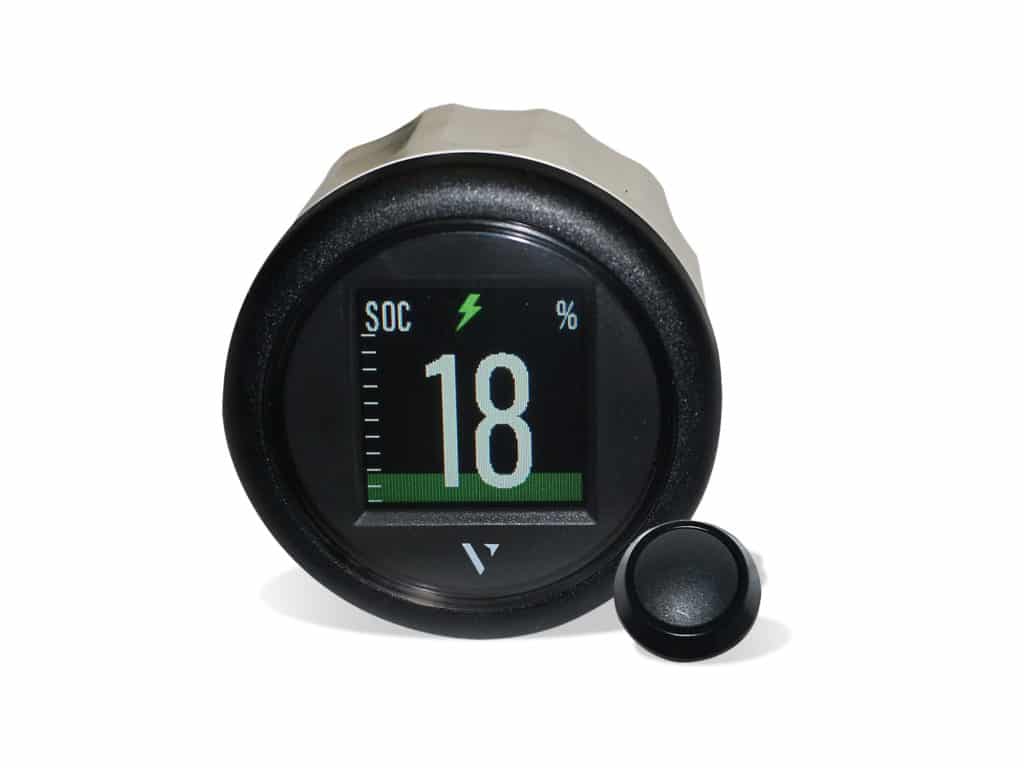
Veratron Intelligent Battery Monitor Kit
$229.99; veratron.com
The Veratron VL Flex gauge fits a 2 1/8-inch hole and comes with a push button to toggle through pages on the gauge. Once installed, it will measure voltage available, amperage draw, battery capacity as a percentage of total capacity, and amperage in during charging. The main voltage screen illuminates in green to the degree of charge, e.g., half green for 50 percent remaining capacity.
In the Box: The kit comes with a gauge, a locking collar, a 19.6-foot wiring umbilical cord with pre-installed connectors for the gauge, button, battery system and other VDO gauges, and a sensor shunt that clamps to the negative battery terminal to measure amperage in and out. Separate IBM kits are available for 12- and 24-volt onboard DC systems.
Installation: It was a complicated installation; however, the instructions were clear and easy to follow. With a few missteps, the gauge took about 40 minutes to connect and make operational. With one practice run—we recommend doing it on a bench—the actual install time could be minimized, with the exception of drilling the gauge and toggle-button holes, and pulling the wires. For a step-by-step explanation of this installation, see our article “Installing a Battery Monitoring System”.
What We Saw: Once connected, the gauge displayed voltage on our 12-volt bank. It was near 12 volts and registered a large fraction of full. We connected an LED strip light to the system and toggled the gauge to display amperage flow, and read the flow to be about 1 amp, as expected for the light. We connected a charger to the battery, and the red arrow pointing upward to depict outflow changed to the green inflow arrow pointing downward and registered 8 amps—normal for our charger. Veratron’s VL Flex Marine app is designed to calibrate all Veratron gauges via Bluetooth. The connection and setup are easy by following the prompts in the app.
Our Take: Despite the complexity, this system was the easiest to wire, thanks to outstanding directions and pre-wired connector plugs minimizing individual wire connections. It is also the clearest to read, thanks to its bright color digital display. The ability to set battery types to AGM, gel or flooded cell (not recommended for lithium types) coupled with the accurate measurement of amp flow made it useful to show constant voltage flow, preventing exhaustion. For fishing boats monitoring lithium trolling-motor banks or cruisers, special equipment is required. The external toggle button requires a second dash penetration.
One surprise: Most of the terminal connectors were not watertight.
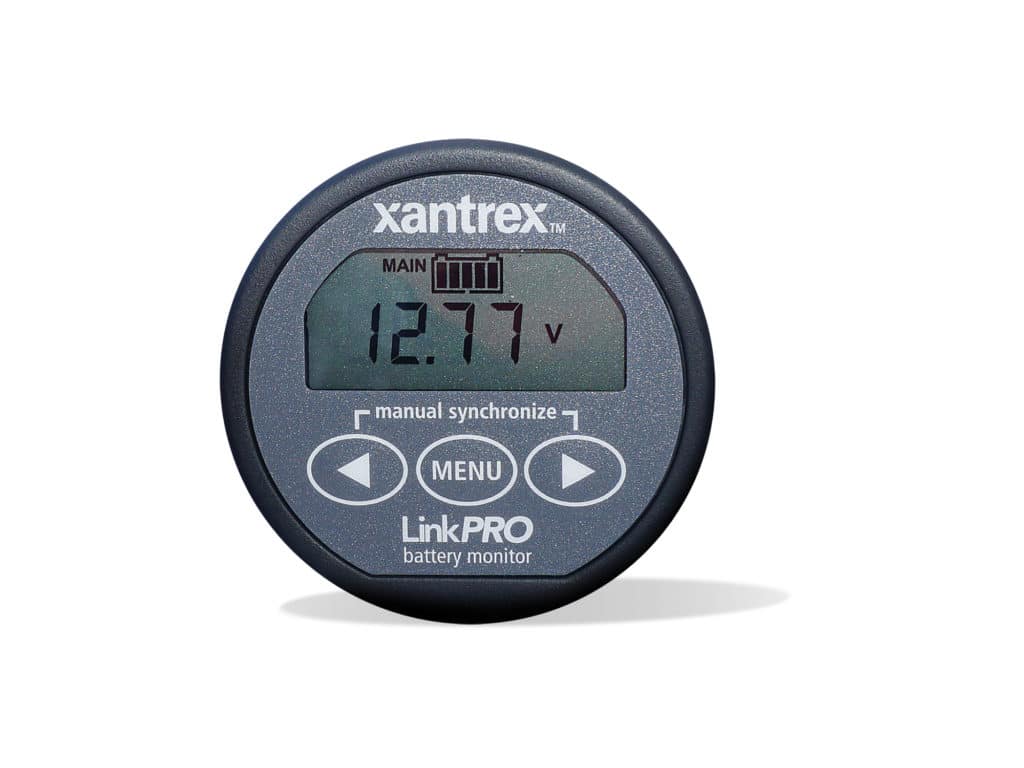
Xantrex Link Pro
$263.53; amazon.com
This device fits in a 2 1/16-inch hole and has a threaded plastic locking collar. The meter display takes up half the gauge’s face, and built-in toggle buttons switch functions and calibrate the gauge to the battery’s capacity, type and voltage. The gauge’s memory records battery events, such as high or low voltage, and a low-voltage alarm can be configured to protect against stranding. The Xantrex Link Pro has an Ethernet cable port for connecting the device to Xantrex chargers and inverters. It is designed for flooded-cell, gel and AGM batteries.
In the Box: The gauge, locking collar, 25-foot cable and sensor shunt are all included in the box, with directions for wiring either a 12- or 24-volt system. Power lines are fused, and fuses are included.
Installation: Connections on the Xantrex charger are analog, and its 25-plus-foot-long connection cable had six color-coded wires inside. Each colored wire had to be inserted into the connector bar on the back of the gauge and, following the color chart provided, connected to the shunt. Battery connections to the shunt were also easy following the color-coded wiring diagram.
What We Saw: The monochrome LCD gauge was simple, but fonts were bold. It is backlit for dim light. We could toggle through the voltage of the battery bank, amperage used, amperage remaining and, if the batteries were charging, the net inflow in amps. The latter setting would tell how much amperage was applied to charge the batteries. When a load was connected, it registered the outflow of amps. The gauge readings weren’t as attractive as on the Veratron gauge, but the LCD readout was clearly visible in sun or shade.
Our Take: Only half the Xantrex gauge is an LCD readout, and the lower half has toggle switches to shift between readouts for amps, volts and charge status. The smaller gauge face is a trade-off for having an integrated switching system, which is not available on the Veratron due to its external toggle assembly. As with the Veratron gauge, we were surprised the connections were not moisture-protected. We think it would be at home on either a sportboat or cruiser to register both draw and charge levels. Directions took some sorting through, but wiring was simple when we found the correct voltage configuration, although tedious due to the individual wire connections.
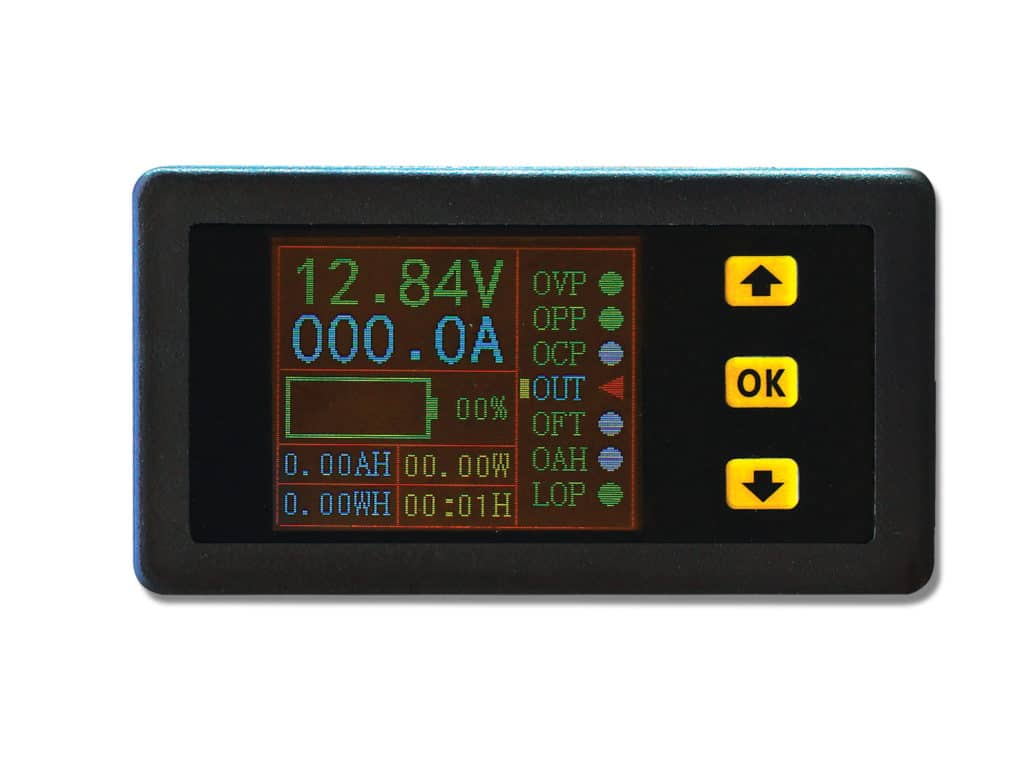
Drok 0-90V DC Ammeter (200485)
$30; amazon.com
This color LCD gauge offers toggle buttons built onto its face. Highly detailed, the gauge displays amps in or out depending on charge or use status. Voltage is also monitored. The screen’s color readout is clear but tiny. Its 3-inch-by-1 9/16-inch dimensions make it compact for flexible mounting options. It is the only one we tested that is designed and programmed for lithium batteries as well as flooded-cell, gel and AGM batteries.
In the Box: It comes with a gauge, one 7-inch-long wiring harness, a 20-inch-long harness, power and ground cables, and a shunt with sensor. Instructions were also included in multiple languages.
Installation: The wiring bus is plug-and-play using either the 7-inch or 20-inch cable supplied. Wiring the sensor and shunt into the battery bank is uncomplicated and easy to do following the included directions. A rectangular gauge hole must be cut with a jig saw, not a hole saw.
What We Saw: The device measured the minute amp draw of the LED light. The readout is bright enough to read in sunlight. Toggle switches on the gauge’s face allow scrolling between voltage, amps and other settings.
Our Take: Basically a plug-and-play device, an ammeter or voltmeter is easy to connect and proved capable of reading the low discharge level of an LED light. However, the supplied cables mean the gauge must be mounted within 7 or 20 inches of the battery banks. The system works well and easily, and can be used to monitor all battery types including lithium up to 80 volts, reporting current voltage, amperage out or in (when charging), and amps used and remaining. Without any waterproofing, the gauge would be better mounted belowdecks. It’s ideal for a cruiser or houseboater.
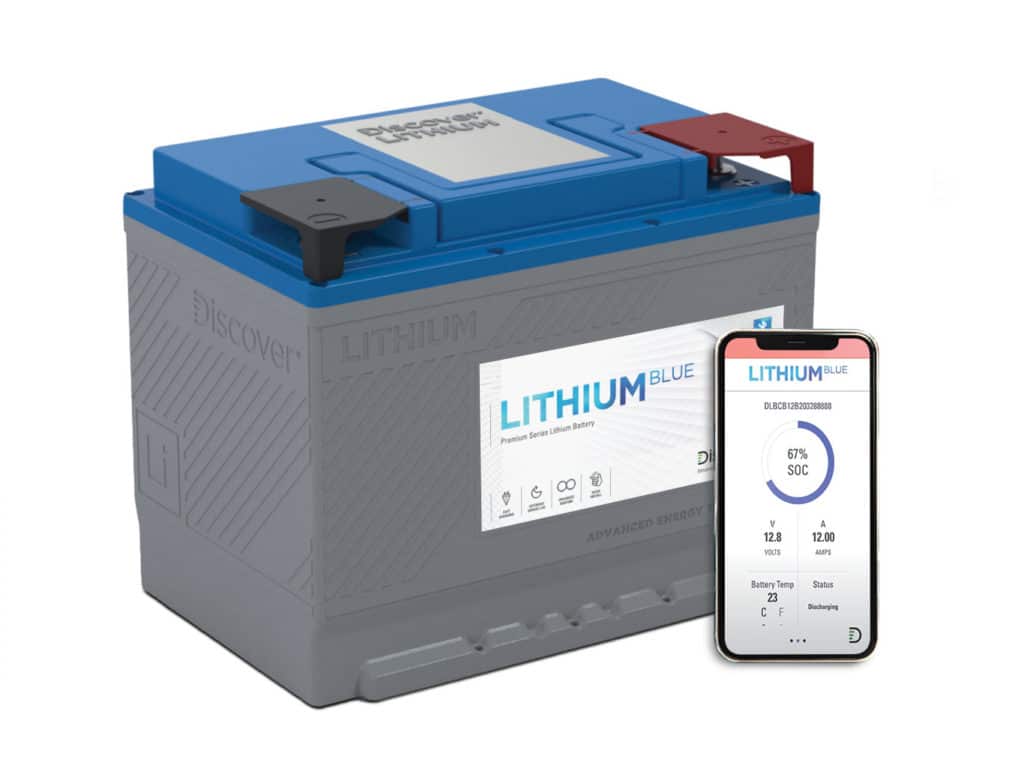
Discover Battery Lithium Blue Battery Monitor App
Free; discoverbattery.com
Lithium Blue batteries are a bank of smaller cells, each combined to create the voltage and amp-hours capacity on the specifications label on the casing. All lithium batteries can be volatile if not discharged or recharged at a safe rate. So, each Lithium Blue battery is equipped with a microprocessor that monitors battery temperature, rate of charge or discharge, voltage stored in each cell of the battery, and the overall condition of the battery. Lithium batteries put out the full rated voltage for the entire cycle, unlike lead-acid batteries, which lose voltage faster and put out less amps as they discharge. Lithium’s technology has unique characteristics that present an unusual challenge for battery-measuring devices. So, Discover Battery installed a Bluetooth transmitter in each battery with the capability of reporting all battery stats.
In the Box: Download the Lithium Blue app at Google Play or iTunes. It will search for active batteries and connect to them.
What We Saw: If Lithium Blue batteries are active (and not asleep for nonuse or low charge), the app will find their Bluetooth signal and connect. Inactive batteries need to be awakened with an active charger, which shoots low voltage to the battery, awakening the microprocessor. Once done, the app found the batteries and listed them with their serial numbers. Tap to connect and read the charge status, voltage, amp capacity and battery temperature. Each battery has a two-page report: One reports the top-line stats, including voltage, amps and battery temperature; the other page offers a detailed battery report on each cell in the battery and a warranty registration portal.
Our Take: The Lithium Blue app not only reports the total voltage, amp capacity and amps remaining in the battery, but it also reports the same for each cell in the battery. This gives not only the most precise readout of each battery’s charge status but also the health of each individual cell. While a typical ammeter or voltmeter might not immediately register the failure of the dozens of cells in a lithium battery, the Lithium Blue microprocessor and app team up to do so. Lithium batteries are ideal for house battery banks, trolling motors and electric propulsion systems. They are not recommended for starting batteries.
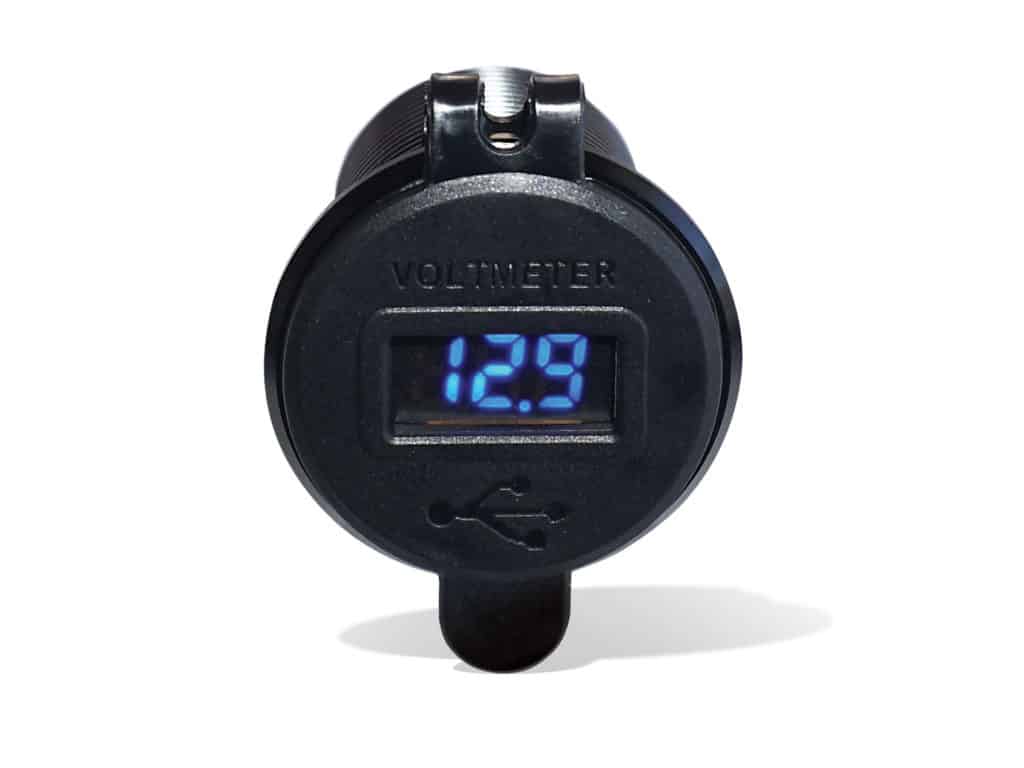
Quick Charge Dual 3.0 USB Charger Voltmeter
$13; amazon.com
One dual USB port charger device fits the hole size of a cigarette-lighter port. It reads out battery voltage while charging two USB devices at 3 amps each. A water-resistant cap fits over the charge ports when not in use, and a small display window allows voltage readings to show through.
In the Box: It comes with a charger/voltmeter plug with a locking ring and attached water-resistant cap. Red and black wiring comes with a fuse holder and fuse.
Installation: Installing it couldn’t be easier. We crimped terminal rings on the cable ends and hooked them to power (red) and ground (black) wires. The mounting hole is easily drilled, and a locking collar holds it in place.
What We Saw: This simple gauge could be connected in companion with a 12-volt power receptacle or in place of one. The voltage readout in a blue LED was legible in daylight or in the dark. USB charge ports are separated by the battery voltage readout, making them easier to pull or insert.
Our Take: In more-involved battery systems, those powering multiple engines and a vast array of navigation electronics and house devices, simply monitoring voltage is insufficient for safe operation out of port. But for a runabout with one or two batteries and an audio system to power, voltage monitoring is adequate if you make sure to charge the starting battery before it dips below 12 volts.








